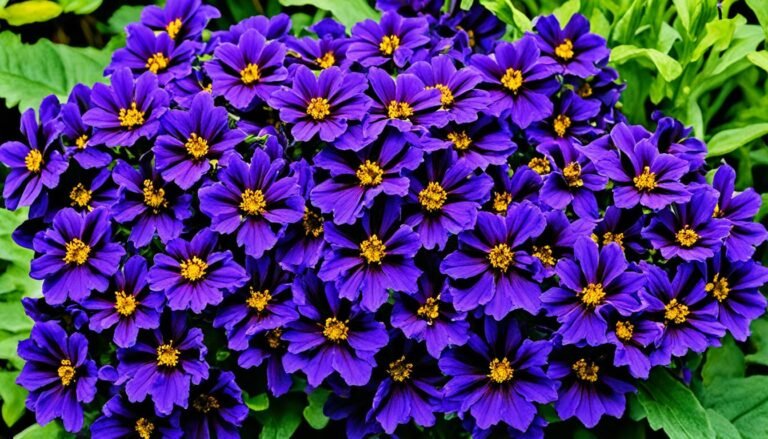Imagine walking through a lush garden, filled with a symphony of colors and fragrances. As you stroll along, your eyes are drawn to a stunning patch of dark purple annual flowers. Their rich, velvety petals seem to dance in the gentle breeze, casting a spell of enchantment over the entire garden.
One particular flower catches your eye – a magnificent petunia with deep purple blooms. Its vibrant color stands out amongst the sea of green, adding a touch of elegance and sophistication to the landscape. You can’t resist reaching out to touch the velvet-like petals, as if trying to capture the essence of its beauty.
But the beauty of dark purple annual flowers doesn’t end with petunias. There are a myriad of other options to explore. From the delicate calibrachoa with its cascading blooms, to the bold and vibrant annual geraniums, these flowers bring a regal touch to any garden.
In this guide, I will take you on a journey through the world of dark purple annual flowers, exploring their care requirements, different varieties, and how to use them to create stunning garden displays. So, let’s dive in and discover the wonders of these exquisite blooms.
Key Takeaways:
- Dark purple annual flowers add a touch of elegance and sophistication to any garden.
- Petunias, calibrachoa, and annual geraniums are just a few examples of dark purple annual flowers.
- In this guide, you will learn how to care for these flowers and create stunning garden displays.
- Dark purple annual flowers are perfect for adding color and beauty to containers, borders, and cut flower arrangements.
- Ready to dive into the world of dark purple annual flowers? Let’s get started!
How to Care for Petunias
Petunias are popular annual flowers known for their vibrant colors and ability to thrive in various garden settings. If you’re planning to grow petunias in your garden, here are some essential care tips to ensure their healthy growth and stunning blooms.
Light and Soil Requirements
Petunias thrive in full sun, so it’s crucial to choose a spot in your garden that receives at least 6 hours of direct sunlight each day. This will help the plants produce more flowers and maintain their vibrant colors. When it comes to soil, petunias prefer well-draining soil that is rich in organic matter. A loamy soil mix is ideal for their growth.
Watering
Proper watering is essential for the health and growth of petunias. These flowers are relatively drought-tolerant, but they still require regular watering to thrive. Water the plants deeply once a week, ensuring that the soil is evenly moist. Avoid overwatering, as this can lead to root rot and other issues.
Fertilizing
To promote large and vibrant flowers, it’s recommended to fertilize petunias once a month during the growing season. Choose a balanced, water-soluble fertilizer and apply it according to the manufacturer’s instructions. This will provide the plants with the necessary nutrients to support robust growth and abundant blooms.
Pruning and Deadheading
Regular pruning and deadheading are crucial for petunia care. Deadheading, or removing faded flowers, helps redirect the plant’s energy towards producing new blooms. Prune the plants as needed to maintain their shape and prevent them from becoming leggy. Trimming back about one-third of the plant’s length can help promote bushier growth.
Container Planting
Petunias are excellent choices for container gardening. Their trailing growth habit makes them perfect for hanging baskets, window boxes, and pots. When planting petunias in containers, make sure to use a well-draining potting mix and place the containers in a sunny location. Regular watering is crucial for container-grown petunias, as they tend to dry out more quickly than those planted in the ground.
By following these petunia care tips, you can enjoy a stunning display of colorful blooms throughout the season. Whether you choose to grow them as mass plantings in your garden or showcase them in hanging baskets, petunias are sure to add beauty and charm to any outdoor space.
| Petunia Care Tips | Summary |
|---|---|
| Light Requirements | Full sun (at least 6 hours a day) |
| Soil Requirements | Well-draining, loamy soil mix |
| Watering | Water deeply once a week |
| Fertilizing | Fertilize once a month during the growing season |
| Pruning and Deadheading | Regularly remove faded flowers and trim for desired shape |
| Container Planting | Use well-draining potting mix and water regularly |
How to Care for Calibrachoa
Calibrachoa plants, also known as Million Bells, are a delightful addition to any garden. These petite flowers resemble mini petunias and come in a variety of bright and beautiful colors. In this section, we will explore the essential care tips for growing calibrachoa and ensuring their healthy and vigorous growth.
Full Sun and Adequate Sunlight
Calibrachoa plants thrive in full sun and require at least 6 hours of sunlight per day to bloom to their full potential. It’s best to plant them in a location where they can receive direct sunlight for the majority of the day. This ensures optimal growth and abundant flowering.
Well-Draining Soil
Calibrachoa prefers well-draining soil to prevent waterlogging and root rot. Amend the soil with organic matter, such as compost or peat moss, to improve drainage and provide essential nutrients for healthy growth. Avoid heavy clay soils that hold water and cause root suffocation.
Regular Watering
Proper watering is crucial for calibrachoa care. These plants have shallow roots, and their soil should be kept consistently moist, but not waterlogged. Water deeply and thoroughly whenever the top inch of soil feels dry. This ensures that the roots are adequately hydrated, promoting lush foliage and abundant flowers.
Fertilizing Routine
Fertilizing calibrachoa is essential to support their continuous blooming throughout the growing season. Use a balanced, water-soluble fertilizer formulated for flowering plants. Apply the fertilizer according to the manufacturer’s instructions, typically once every two weeks. Deeply water the plants after each fertilizing treatment to prevent roots from burning.
By following these care tips, you can enjoy the vibrant and cascading blooms of calibrachoa in your garden. These low-maintenance plants are an excellent choice for containers, hanging baskets, or as a ground cover in flowerbeds.

How to Care for Annual Geraniums
When it comes to adding vibrant color to your garden, annual geraniums are an excellent choice. Whether you plant them as bedding plants or in hanging baskets, these flowers thrive in sunny areas with rich, well-draining soil. Here are some essential tips for growing healthy and beautiful annual geraniums:
- Choose the right location: Find a sunny spot in your garden where the geraniums will receive at least 6 hours of direct sunlight each day. This will help them grow vigorously and produce abundant blooms.
- Prepare the soil: Ensure the soil is well-draining by adding organic matter such as compost or peat moss. This will help prevent waterlogging and root rot, which can be detrimental to your plants.
- Watering: Water your geraniums regularly, aiming for a consistent level of moisture without overwatering. Allow the top inch of soil to dry out before watering again. Avoid wetting the leaves as this can lead to disease.
- Deadheading: Deadhead the faded flowers regularly to promote new blooms. This not only keeps your geraniums looking tidy but also encourages continuous flowering throughout the season.
- Fertilizing: Feed your geraniums with a balanced, water-soluble fertilizer once every two weeks during the growing season. This will provide them with essential nutrients and promote healthy growth.
- Overwintering: Annual geraniums are not frost-tolerant, so if you live in a colder climate, you’ll need to take steps to overwinter them. Before the first frost, carefully dig up the plants and pot them in containers. Place them in a cool, well-lit area indoors and reduce watering. Resume regular care in the spring and replant them outdoors once the danger of frost has passed.
By following these care tips, you can ensure that your annual geraniums thrive and bring joy to your garden throughout the growing season. Now let’s take a closer look at the different varieties of purple annual flowers in the next section.
How to Care for Miscellaneous Annuals
Miscellaneous annuals come in various species, but there are some universal care tips to ensure their healthy growth in your garden. By following these care tips, you can maintain the beauty and vigor of your miscellaneous annuals throughout the growing season.
Planting in Well-Draining Soil
When it comes to planting miscellaneous annuals, choosing well-draining soil is crucial. These plants thrive in soil that allows excess water to flow away, preventing root rot and other water-related issues. Ensure proper drainage by amending the soil with organic matter such as compost or peat moss.
Moderate Watering
While it’s important to keep your miscellaneous annuals properly hydrated, it’s equally important not to overwater them. Overwatering can lead to root rot and other fungal diseases. Water your plants deeply, allowing the soil to dry out slightly between waterings. This will encourage healthy root development and prevent waterlogged conditions.
The Right Balance of Fertilizer
Applying fertilizer to your miscellaneous annuals once a month will provide them with the necessary nutrients for vigorous growth. However, it’s important not to over-fertilize, as excess fertilizers can burn the plants and negatively impact their overall health. Always follow the instructions on the fertilizer package and use the recommended amount for your specific plant species.
Sunlight Requirements
Most annuals require some sunlight to thrive and produce vibrant blooms. Ensure that your miscellaneous annuals receive adequate sunlight based on their specific requirements. Some varieties may need full sun, while others may tolerate partial shade. Be sure to place them in a location that matches their sunlight needs for optimal growth.
To summarize, caring for miscellaneous annuals involves planting them in well-draining soil, moderate watering, providing the right balance of fertilizer, and ensuring they receive the appropriate amount of sunlight. By following these care tips, you can enjoy the beauty and versatility of miscellaneous annuals in your garden.
Types of Purple Annual Plants
Purple annual plants are a colorful and vibrant choice for any garden. They add a touch of elegance and beauty with their stunning blooms. In this section, I will introduce you to some popular purple annuals, along with their unique characteristics and care requirements.
1. Petunias: Petunias are one of the most popular choices for purple annuals. They come in a variety of shades, including deep purple, lavender, and violet. Petunias are known for their ability to bloom abundantly throughout the season. They can be planted in containers, hanging baskets, or flower beds.
2. Calibrachoa: Calibrachoa, also known as Million Bells, are small but mighty purple annuals. They produce an abundance of trumpet-shaped flowers in shades of purple, lavender, and mauve. Calibrachoa plants are perfect for hanging baskets, as their cascading growth habit creates a stunning display.
3. Annual Geraniums: Annual geraniums come in various shades of purple, including dark purple, magenta, and violet. They are known for their long-lasting blooms and attractive foliage. Annual geraniums thrive in well-draining soil and prefer full sun. They can be used in flower beds or containers.
4. Lobelia: Lobelias are delicate purple annuals that add a touch of elegance to any garden. They have small, vibrant flowers in shades of blue-purple. Lobelias prefer moist soil and can be planted in hanging baskets, window boxes, or along garden borders.
5. Cockscomb: Cockscomb, also known as Celosia, is a unique purple annual with bold, feathery blooms resembling the shape of a rooster’s comb. They come in shades of deep purple and are sure to make a statement in any garden. Cockscomb plants prefer full sun and well-draining soil.
6. Cornflower: Cornflowers, also known as Bachelor’s Buttons, are charming purple annuals with delicate, daisy-like flowers. They come in shades of lavender, violet, and deep purple. Cornflowers are easy to grow and attract pollinators to your garden. They can be planted in flower beds or containers.
To summarize, there are various types of purple annual plants that can add a pop of color and beauty to your garden. From petunias to calibrachoa, each variety offers its own unique charms. Consider incorporating these popular purple annuals into your garden for a stunning display that will surely impress.
| Purple Annual Plants | Unique Characteristics | Care Requirements |
|---|---|---|
| Petunias | Abundant blooms in various shades of purple | Full sun, well-draining soil, regular watering and fertilizing |
| Calibrachoa | Cascading growth habit, trumpet-shaped flowers | Full sun, well-draining soil, regular watering, and occasional pruning |
| Annual Geraniums | Long-lasting blooms, attractive foliage | Well-draining soil, full sun, regular watering, and deadheading |
| Lobelia | Delicate flowers in shades of blue-purple | Moist soil, partial shade, regular watering |
| Cockscomb | Bold, feathery blooms resembling a rooster’s comb | Full sun, well-draining soil, regular watering, and occasional fertilizing |
| Cornflower | Charms with delicate, daisy-like flowers | Well-draining soil, moderate water, full sun to partial shade |
Purple Annual Flowers for Specific Effects
Purple annual flowers can have a profound impact on the overall aesthetic of your garden. The rich and vibrant hues of purple can evoke specific moods and create various visual effects. Let’s explore how different shades of purple can be used in garden design to achieve specific effects.
- Subdued shades of lavender: Subtle and calming, lavender-toned purple annual flowers like Lavender Lantana or Violet Snapdragons can create a serene and peaceful atmosphere in your garden. Their soft and delicate appearance can be used to add a touch of tranquility to any space.
- Brighter hues like magenta: If you’re looking to make a bold statement, using vibrant magenta-colored annual flowers such as Magenta Geraniums or Purple Verbena can add excitement and drama to your garden. Their eye-catching and energetic presence is sure to draw attention and create a lively atmosphere.
- Harmonious hues of blue, silver, and white: Purple blends beautifully with various colors, especially shades of blue, silver, and white. You can pair purple annual flowers like Purple Petunias or Silver Dust Lavender with these complementary colors to achieve a cooling and soothing effect. The combination of these hues creates a harmonious and elegant garden.
- Contrasting shades of orange, yellow, and red: For a visually striking and vibrant garden design, consider pairing purple annual flowers with contrasting shades like orange, yellow, and red. The juxtaposition of these colors creates a dynamic and visually stimulating effect. Vibrant purple flowers like Purple Coneflowers or Dark Purple Sunpatiens can be combined with these bold hues to create a visually captivating display.
By strategically incorporating purple annual flowers with other colors and considering their specific effects, you can create a garden design that reflects your personal style and desired ambiance.
Example of Purple Annual Flowers for Specific Effects
Take a look at this table showcasing some popular purple annual flowers and their specific effects:
| Flower | Specific Effect |
|---|---|
| Purple Petunias | Evoke a sense of elegance and tranquility |
| Magenta Geraniums | Add vibrancy and energy to the garden |
| Lavender Lantana | Create a calming and serene atmosphere |
| Purple Verbena | Add excitement and drama to the garden |
| Purple Coneflowers | Create visual tension and contrast |
| Dark Purple Sunpatiens | Provide a bold and captivating presence |

Utilize the power of purple annual flowers to create the desired ambiance and visual impact in your garden. Whether you prefer a calming retreat or a vibrant showcase, the versatile shades of purple can transform your outdoor space into a captivating oasis.
Purple Annual Flowers for Containers
When it comes to adding a vibrant touch to your container garden, purple annual flowers are an excellent choice. Not only do they bring a burst of color to your outdoor space, but they also thrive in the confined environment of a container. Whether you have a small balcony or a spacious patio, purple annuals can create a stunning display that will delight both you and your guests.
There are several popular purple annual flowers that are well-suited for planting in containers:
- Petunias: These versatile and colorful flowers come in a range of shades, including deep purples and vibrant magentas. They are easy to care for and can be grown in hanging baskets or pots.
- Calibrachoa: Also known as Million Bells, calibrachoa produces an abundance of small purple flowers throughout the season. They are perfect for cascading down the sides of containers or hanging baskets.
- Sweet Alyssum: With its delicate clusters of tiny purple flowers, sweet alyssum adds a touch of elegance to any container garden. It has a lovely fragrance and can be planted as a border or filler plant.
These purple annuals can be combined with other complementary colors, such as white, pink, or blue, to create a visually stunning arrangement. The contrasting colors will enhance the beauty of the purple flowers and add depth and interest to your container garden.
| Flower | Description | Care Tips |
|---|---|---|
| Petunias |  | Petunias thrive in full sun and well-draining soil. Water them regularly and fertilize once a month for optimal growth. |
| Calibrachoa | 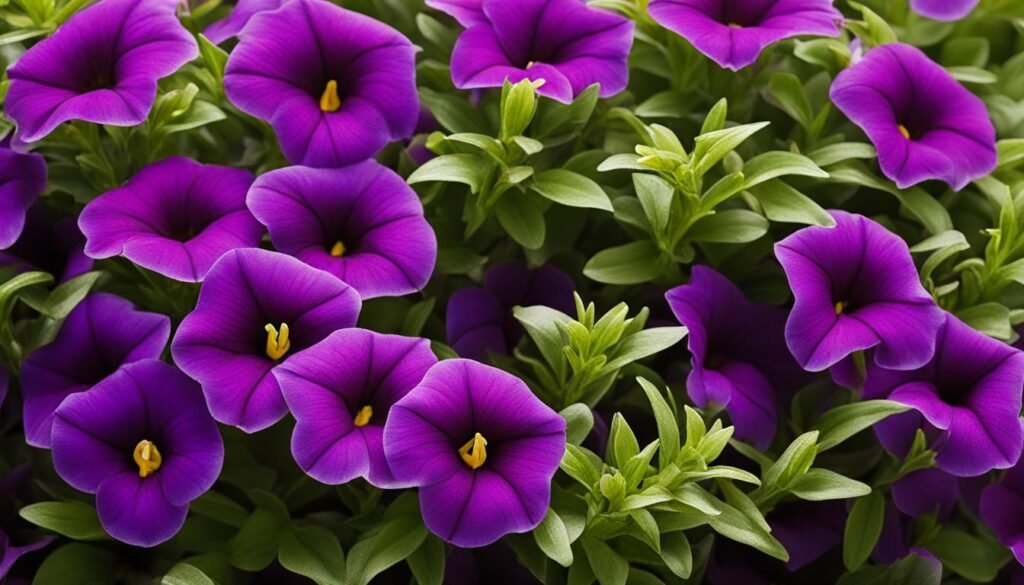 | Calibrachoa loves full sun and requires regular watering. Fertilize every two weeks to promote abundant flowering. |
| Sweet Alyssum | 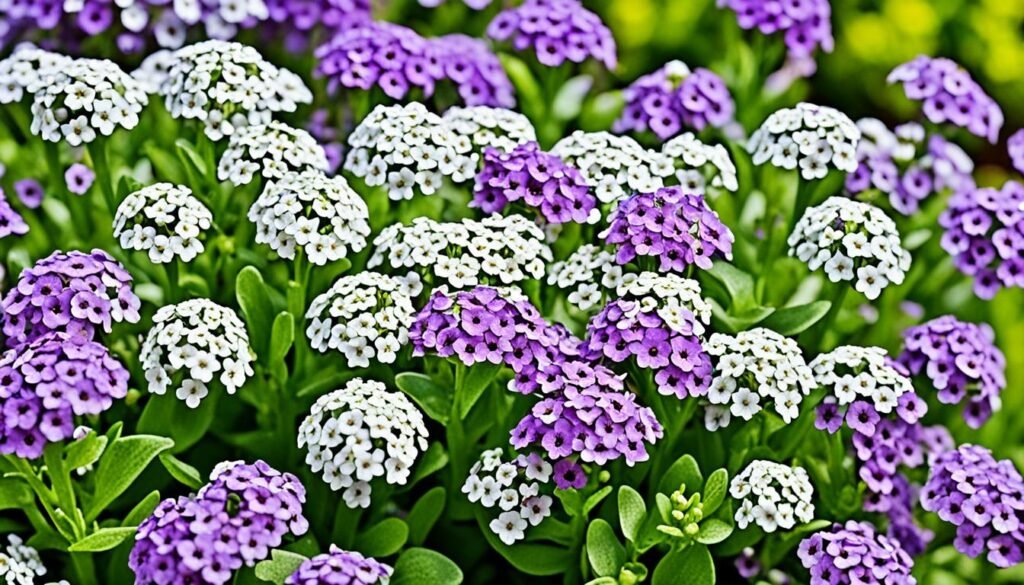 | Sweet alyssum prefers full sun to partial shade and well-draining soil. Water regularly and deadhead spent blooms to encourage new growth. |
With their vibrant colors and compact growth habits, these purple annuals are perfect for creating eye-catching container displays. Whether you’re looking to liven up your patio or add a touch of color to your front porch, these flowers will bring beauty and joy to any space.
Purple Annual Flowers for Borders
When it comes to borders in your garden, purple annual flowers can play a vital role in enhancing the overall aesthetic appeal. With their vibrant hues and captivating blooms, flowers like geraniums, lobelia, and cornflower can add a pop of color and create a cohesive look along the edge of a garden bed.
One effective way to utilize purple annual flowers in borders is by mixing different shades of purple with other complementary colors. This creates a stunning border display that catches the eye and adds depth to your garden design. Consider combining purple flowers with shades of pink, white, or blue to create an eye-catching contrast.
Here is an example of how you can arrange purple annual flowers in a border:
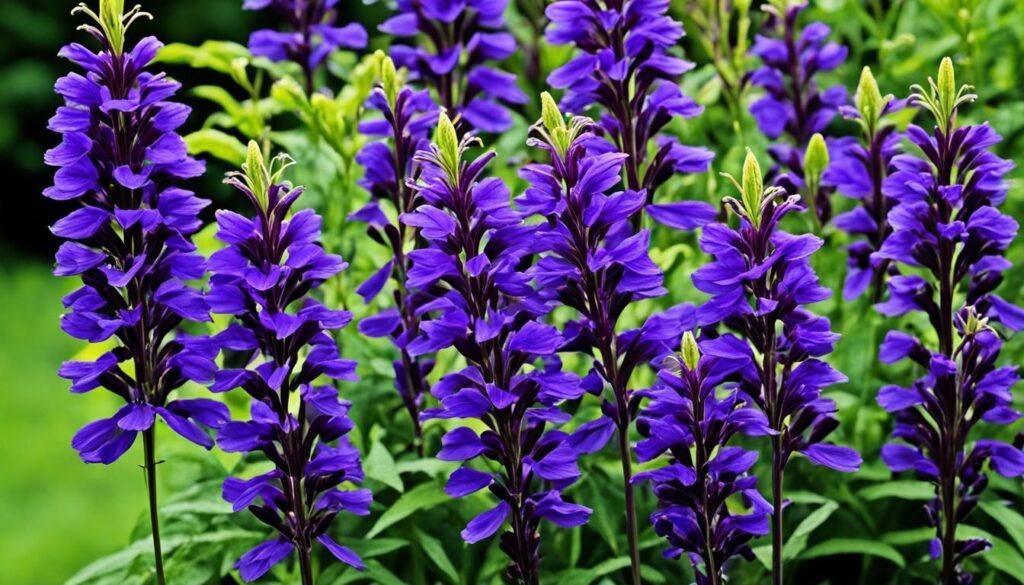
| Plant | Height | Flower Color |
|---|---|---|
| Geranium ‘Rozanne’ | 12-24 inches | Purple |
| Lobelia ‘Crystal Palace’ | 6-8 inches | Deep Blue |
| Cornflower ‘Blue Diadem’ | 18-24 inches | Blue |
This combination of purple geraniums, deep blue lobelia, and blue cornflower creates a striking border that showcases the beauty of purple flowers while maintaining a cohesive look.
Using purple annual flowers in borders not only adds color, but it also helps define the edges of your garden beds, giving them a polished and well-maintained appearance. Whether you have a formal or informal garden, purple annual flowers can bring a touch of elegance and charm to the overall landscape.
Purple Annual Flowers for Cut Flower Arrangements
When it comes to creating stunning floral arrangements, purple annual flowers are an excellent choice. Their vibrant colors and delightful fragrance can add a touch of elegance to any bouquet. If you’re looking to incorporate purple flowers into your cut flower arrangements, consider these popular options:
- African Daisies: These beautiful daisy-like flowers come in shades of purple and bloom abundantly. Their unique petal patterns and long stems make them perfect for adding height and drama to bouquets.
- Sweet Alyssum: With its delicate clusters of small, fragrant flowers, sweet alyssum adds a charming touch to any arrangement. The soft purple blooms complement a variety of other flowers and foliage.
- Snapdragons: Known for their tall spikes of colorful blooms, snapdragons come in various shades of purple. Their vertical shape adds structure and visual interest to bouquets, making them ideal for mixed arrangements.
By incorporating these purple annual flowers into your cut flower arrangements, you can create beautiful displays that are both visually appealing and fragrant.
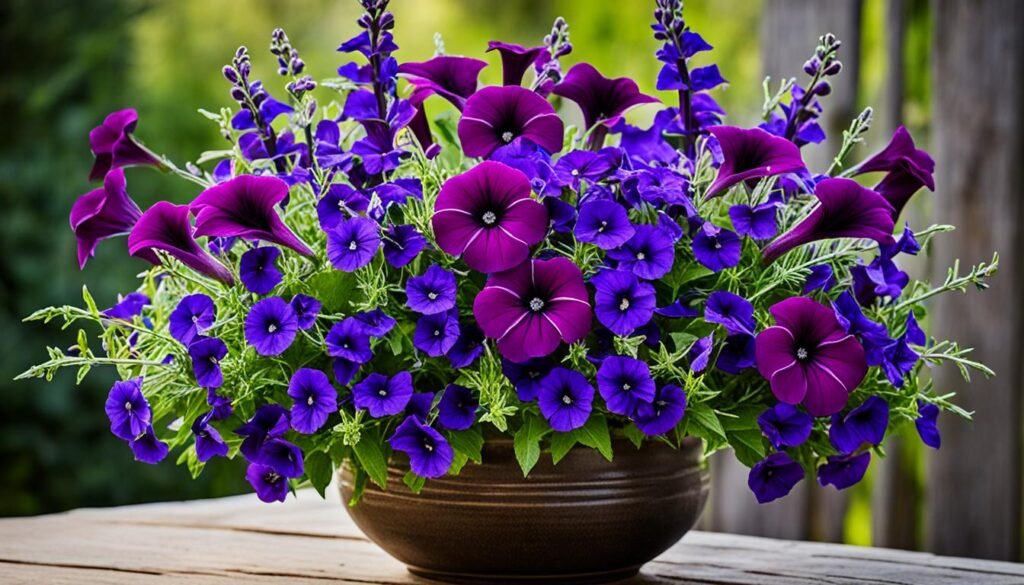
| Flower | Characteristics |
|---|---|
| African Daisies | Daisy-like blooms in shades of purple, unique petal patterns, long stems |
| Sweet Alyssum | Clusters of small, fragrant flowers, soft purple blooms |
| Snapdragons | Tall spikes of colorful blooms, vertical shape |
Where to Buy Dark Purple Annual Flowers
Looking to add the beauty of dark purple annual flowers to your garden? You’re in luck! There are numerous online nurseries where you can find a wide selection of these stunning plants. One option you can explore is Garden Goods Direct. They offer a variety of dark purple annual plants that will add a touch of elegance to your outdoor space.
When you visit Garden Goods Direct’s website, you’ll find a range of options to choose from. Whether you’re looking for petunias, calibrachoa, or other popular purple annuals, they have you covered. Their user-friendly website makes it easy to browse and select the perfect plants for your garden.
Not only does Garden Goods Direct provide high-quality plants, but they also prioritize customer satisfaction. With their knowledgeable team of experts, you can expect top-notch customer service and valuable guidance throughout your purchasing experience.
So, why wait? Visit Garden Goods Direct’s website today and turn your garden into a stunning display of dark purple annual flowers. Explore their collection, choose your favorites, and create a garden that will truly make a statement.
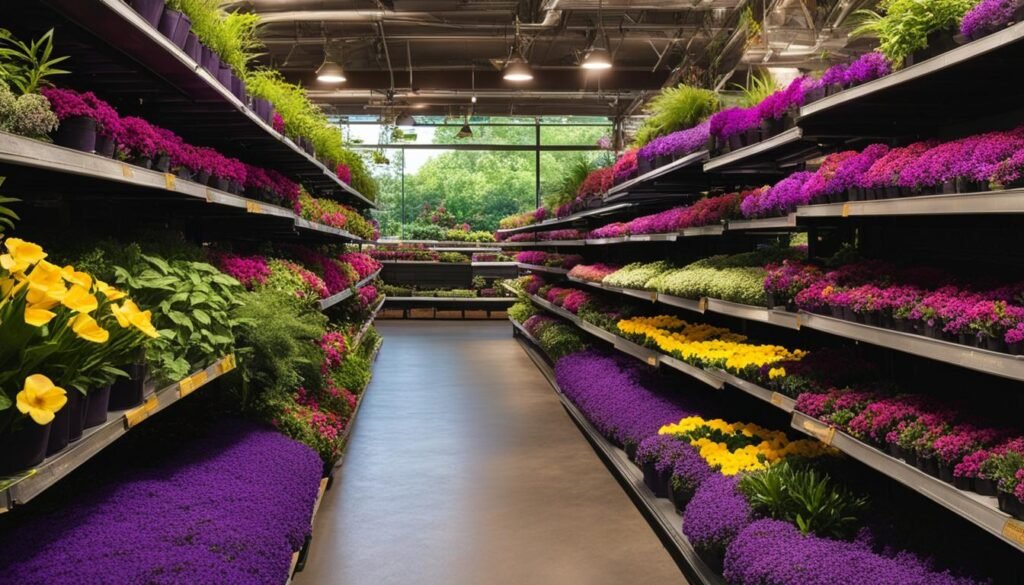
| Benefits of Buying from Garden Goods Direct | Garden Goods Direct |
|---|---|
| Wide selection of dark purple annual flowers | ✓ |
| Easy-to-use website for convenient browsing | ✓ |
| Expert customer service for guidance and support | ✓ |
| High-quality plants for a vibrant and thriving garden | ✓ |
Conclusion
Dark purple annual flowers are a stunning addition to any garden. These exquisite blooms, such as petunias, geraniums, and more, offer a touch of regal elegance and enchantment. By following proper care tips and selecting the right varieties, you can create a vibrant and colorful garden display that will leave everyone in awe.
Whether you choose to plant dark purple annuals in containers, use them to line your garden borders, or include them in cut flower arrangements, these flowers are sure to make a statement. Their deep purple hues bring depth and richness to your outdoor space, creating a captivating visual impact.
For the best results, choose the best dark purple annual flowers that suit your garden’s needs and your personal preferences. Ensure they receive the right amount of sunlight, well-draining soil, and regular watering. Whether you’re a seasoned gardener or just starting, incorporating dark purple annual flowers into your garden will add a touch of elegance and sophistication that will be admired by all.
